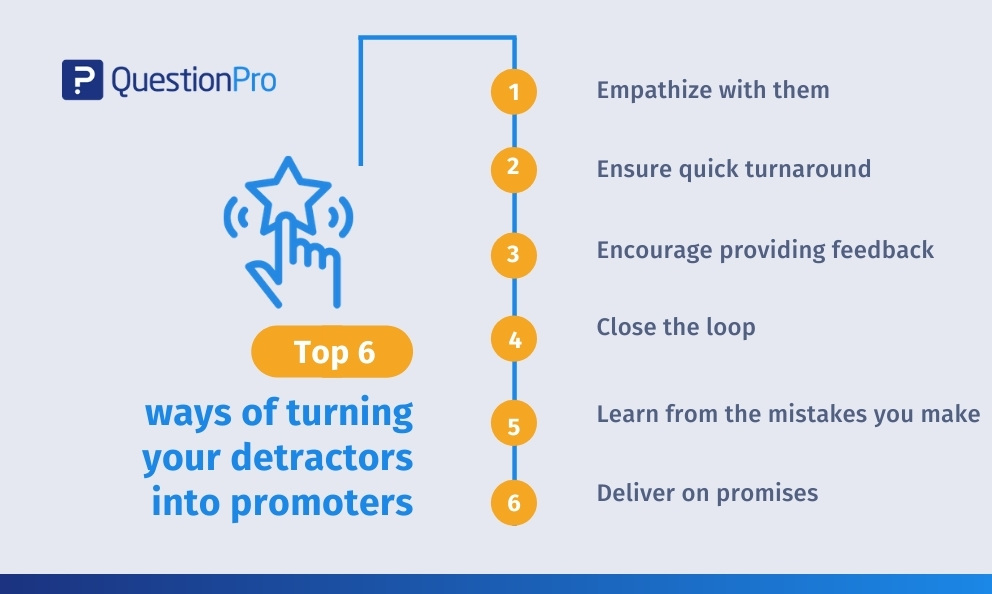 Reading Time: 4 minutes read
Reading Time: 4 minutes read
A Net Promoter Score (NPS) survey gives you an idea of customer satisfaction and loyalty. It lets you know who your dissatisfied or angry customers, also known as detractors, are. Detractors are a concern for brands not only because they are a churn risk but also because they will speak to various costumers and potential customers about their bad experiences.
Why is identifying detractors important?
- Contain negative word of mouth
A delighted customer will tell 10 people about their delightful experience, but detractors will tell a lot more. Detractors after churning and before churning will spread bad word of mouth affecting your brand’s reputation. As per a recent study, 75% of customers said they shared bad customer experience feedback or experience as opposed to 42% of customers who shared positive experiences.
- Detractors affect your sales and revenue
Detractors do not buy from you and also affect your sales through negative word of mouth. This directly adversely affects your business revenue. It is highly expensive to acquire new customers than retaining existing ones. When detractors leave, it forces them to look for new customers and also repair the damage that detractors may have caused due to negative feedback about your brand’s products and services.
LEARN ABOUT: Service Recovery
- Detractors are a churn risk
Customer churn is the percentage of consumers that have stopped buying or using your products for a period. They may have switched to a competitor brand of yours. Detractors may switch to another brand at the earliest opportunity. A study by Inc.com suggested about 50% of detractors will likely to churn within ninety days. Higher the churn rate, severe are the losses to revenue and profits.
How to turn your detractors into promoters
So how can you convert your detractors into promoters? Promoters are loyal customers, fierce brand advocates, and contribute to the brand’s business revenue significantly. We’ve outlined some key steps for you to follow and transform your detractors to promoters.
1. Encourage providing feedback
No matter what organizations would like to believe, there are usually more unsatisfied customers than satisfied. Lack of customer complaints isn’t proof that all is well. This is where seeking customer feedback comes in handy. It gives you a view of what the customers think if they are satisfied or not, and if not, how can satisfaction levels be improved. If you have no idea where you are lacking or what’s standing in the way of great customer experience, you will never have that good NPS score. Customers appreciate organizations that seek feedback and act on it. It shows them that brands care and customer satisfaction is their top priority. Be proactive in approaching your consumers, do not do customer surveys just because it’s a task, and don’t absolutely do it only once a year.
LEARN ABOUT: Good Net Promoter Score (NPS)
2. Ensure quick turnaround
Whenever there are customer queries or complaints, make sure you resolve them right away. Your customers will appreciate you replying instantly and trying to find a solution. They understand that a viable solution may not always be available and can take some time. Telling them honestly so will only work in your favor. One quick comment on social media due to delays can damage your brand reputation and revenue. Put yourself in their shoes and approach any issues. If you do not recognize their concern in an hour, it will not be worthwhile coming up with a solution a day later. Speak to managers if there are hindrances affecting your turnaround times. It can be resources, systems, or automation; it will only help to bring it forward and devise a solution.
3. Empathize with them
When customers face a problem, it may not be a unique situation for you, but it is for them. You need to empathize with your detractors and approach the situation in that way. That is the top reason for customers wanting to chat with support representatives. It is very easy to install live chats or chatbots, but they lack the human touch. And it can frankly be quite annoying for your customers that are already struggling with something. Listen to your customers, understand their problems, and propose relevant solutions. Hearing to their concerns will understand pain points and give you data to improve your product or service further.
4. Close the loop
You need to respond to your detractors quickly and resolve their concerns and queries politely is important. That is not the only step; you need to share their feedback and data with other functions too to improve customer experience. You can use a platform such as QuestionPro CX to close the feedback loop. It helps in capturing their customers’ journey at several touchpoints and gather insightful data. Understand customer behavior to know what factors drive it.
5. Learn from the mistakes
Unsatisfied customers are your biggest source of knowledge. They will help you improve your customer experience and satisfaction. It is not merely about boosting your NPS score by ‘X’ amount of points or having a better score than your competitors. It is about building trust and ensuring, and you have their best interests at heart. A customer that was annoyed by a less than favorable experience can be your biggest advocate if you address their concerns properly and timely.
6. Deliver on promises
Many organizations are guilty of overpromising and not keeping up to it. Be it about product features, resolving customer queries, or something else. Only make assurances that you can keep and deadlines that you can meet. If you are unable to find a viable solution, be upfront about it, and propose the next best solution. If issuing a refund is going to make your detractors happy, do that!
You can use QuestionPro CX to manage your CX initiatives and detractor recovery. Sign up for a free CX account to test the platform.







